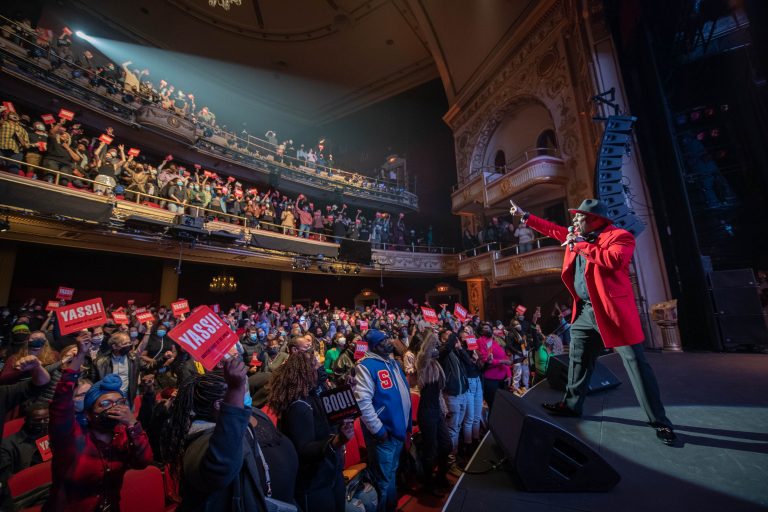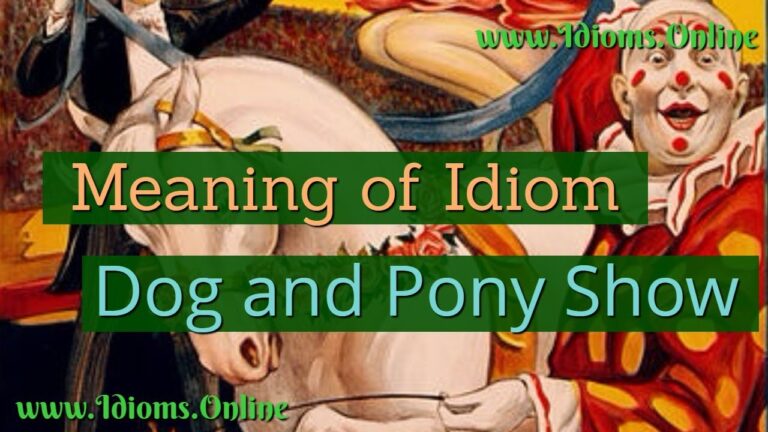Have you ever heard someone mention a “dog and pony show” and found yourself puzzled by its meaning? This common phrase holds a deeper significance than its literal interpretation. In today’s blog, we are going to delve into the essence of the dog and pony show meaning—unveiling its true connotation and shedding light on its cultural origins. Understanding this idiom is not only essential for enriching your vocabulary but also for comprehending the subtleties of communication in various contexts. So, let’s embark on a journey to decipher the enigmatic phrase “dog and pony show” and discover what it truly signifies in our everyday interactions.
Understanding the Concept of a ‘Dog and Pony Show’
In the realm of business and entertainment, the term ‘dog and pony show’ has become synonymous with a spectacle or presentation that is flashy but lacking in substantive content. The phrase is often used to describe a situation where elaborate displays or performances are used to mask a lack of genuine substance or to distract from underlying issues.
The Origins of the Term
The term ‘dog and pony show’ has its roots in 19th-century America, where traveling circuses and fairs would feature literal displays of dogs and ponies performing tricks to attract audiences. Over time, the phrase evolved to represent any performance or presentation that prioritizes style over substance.
Modern Usage and Examples
In contemporary contexts, the concept of a ‘dog and pony show’ is often applied to situations such as corporate presentations, political campaigns, or product launches where flashy visuals and grandeur are used to impress, yet the actual content or value may be lacking.
- Corporate Events: Companies may organize elaborate events or product reveals that focus more on spectacle than on providing meaningful information to investors or consumers.
- Political Campaigns: Politicians and public figures may engage in ‘dog and pony shows’ during debates or speeches, using charisma and theatrics to sway public opinion.

Origins and History of the Term
The term “dog and pony show” dates back to the early 20th century and originates from the world of entertainment, specifically circuses and traveling shows.
Early Usage
The expression was commonly used to describe a small-scale, often repetitive or gimmicky performance intended to attract and entertain audiences, typically featuring trained dogs and ponies.
**It was not until the 1940s that the term began to be applied metaphorically outside of the entertainment industry, expanding to describe any elaborate or overly theatrical presentation meant to impress or distract rather than inform or accomplish real work.**
Popularity and Evolution
**By the mid-20th century, “dog and pony show” had become a common idiom in business and politics, used to critique presentations that were more style than substance or lacked authenticity.**
**Over time, the term evolved to encompass any flashy, superficial display that prioritizes appearance over content or meaningful action, reflecting a growing skepticism towards flashy presentations with little real value.**
Usage of ‘Dog and Pony Show’ in Different Contexts
When we talk about the dog and pony show meaning, it refers to a presentation or event that is elaborately staged to create a favorable impression. This expression is commonly used to describe situations where an elaborate performance is put on to impress or distract without much substance or value behind it. In different contexts, the usage of ‘dog and pony show’ varies, highlighting the superficiality or spectacle over substance.
Political Arena
In the realm of politics, ‘dog and pony show’ often refers to political rallies, debates, or press conferences that focus more on appearances and showmanship rather than addressing real issues. Politicians may engage in a dramatic performance to sway public opinion or distract from important matters.
Corporate World
Within the corporate world, ‘dog and pony show’ can be seen in elaborate product launches, flashy presentations, or extravagant company events that aim to impress stakeholders without necessarily delivering substantial results. The emphasis on style over substance can sometimes detract from the core business objectives.
Entertainment Industry
In the entertainment industry, the term ‘dog and pony show’ can be used to describe excessive hype or promotional gimmicks used to attract audiences to movies, TV shows, or music releases. It highlights the performative nature of marketing campaigns that prioritize buzz over the actual quality of the content.
Interpretations and Symbolism Involved
When delving into the dog and pony show meaning, it’s crucial to explore the various interpretations and symbolism associated with this term. The phrase “dog and pony show” typically refers to a presentation or event that is elaborate, but lacking in real substance. It often involves a flashy display meant to distract or impress rather than convey genuine information or value.
Historical Origins
The origins of the term “dog and pony show” can be traced back to circuses and traveling shows in the early 20th century. These shows often featured trained dogs and ponies performing tricks and stunts to entertain audiences. Over time, the term evolved to represent any performance or spectacle that is more style than substance.
Understanding the historical context of the term provides insights into how it has come to symbolize superficiality and deception in modern contexts.
Modern-Day Usage
In contemporary settings, the term “dog and pony show” is frequently used in business, politics, and other arenas to describe presentations or events that focus on appearance rather than content. These ostentatious displays often aim to impress or distract, taking the spotlight away from relevant issues or weaknesses.
This symbolic association underscores the importance of looking beyond surface appearances and examining the substance of any performance or presentation.
Relevance of the Term in Today’s Society
In today’s society, the term “dog and pony show” holds significant relevance, especially in the context of elaborate yet superficial presentations that aim to impress rather than convey substantial value. This phrase, often used in a metaphorical sense, alludes to performances or displays intended to distract or deceive, typically in the business or political realm. With the growing emphasis on image and presentation in the era of social media and instant communication channels, the concept of a dog and pony show has become more prevalent than ever.
Evolution of Presentation Tactics
The evolution of technology and the advent of digital platforms have transformed the way information is shared and consumed. As a result, there is a heightened emphasis on creating visually appealing and attention-grabbing content. Companies and individuals often resort to elaborate presentations and flashy demonstrations to capture the fleeting attention of modern audiences.
This trend has led to the proliferation of dog and pony shows in various sectors, where style sometimes prevails over substance, and appearances are prioritized over authentic content.
Impact on Decision-Making Processes
The prevalence of dog and pony shows can have a profound impact on decision-making processes. When individuals or organizations prioritize style and theatrics over genuine value and merit, the risk of making ill-informed choices increases. It becomes crucial for consumers, investors, and voters to look beyond the facade of a dog and pony show and seek out authentic information and meaningful interactions.

Frequently Asked Questions
- What is the origin of the term ‘Dog and Pony Show’?
- The term ‘Dog and Pony Show’ originated in the 19th and early 20th centuries in the United States, referring to a small traveling circus or carnival act that featured trained dogs and ponies performing tricks for entertainment.
- What does the ‘Dog and Pony Show’ signify in today’s context?
- In contemporary usage, the term ‘Dog and Pony Show’ is often used metaphorically to describe a presentation or event that is elaborate, showy, or overly theatrical but lacks substance or genuine value.
- Why do people use the expression ‘Dog and Pony Show’ in business or politics?
- It is commonly used in business or politics to criticize presentations, meetings, or events that are more about appearance, spectacle, or superficiality rather than meaningful content or productive discussion.
- Are there any positive aspects associated with a ‘Dog and Pony Show’?
- While the term is typically used in a negative context, some argue that a well-executed presentation or event, even if flashy, can effectively capture attention and engage audiences, thereby achieving its intended goals.
- How can one avoid falling into the trap of organizing a ‘Dog and Pony Show’?
- To prevent a presentation or event from becoming a ‘Dog and Pony Show’, it is essential to focus on substance, authenticity, and delivering value to the audience rather than solely on flashy visuals or theatrics.
Unlocking the Essence of the Dog and Pony Show Meaning
As we conclude our journey into the enigmatic world of the dog and pony show meaning, it becomes evident that this term goes beyond mere entertainment. It symbolizes the elaborate presentation of façades and illusions, often seen in corporate settings or political arenas. Understanding the dog and pony show empowers us to see through the smoke and mirrors, encouraging a discerning eye towards authenticity and transparency. By peeling back the layers of this concept, we become more adept at recognizing insincerity and demanding substance over style. Let us carry forth this insight into our interactions, ensuring that we navigate through life with clarity and insight.



